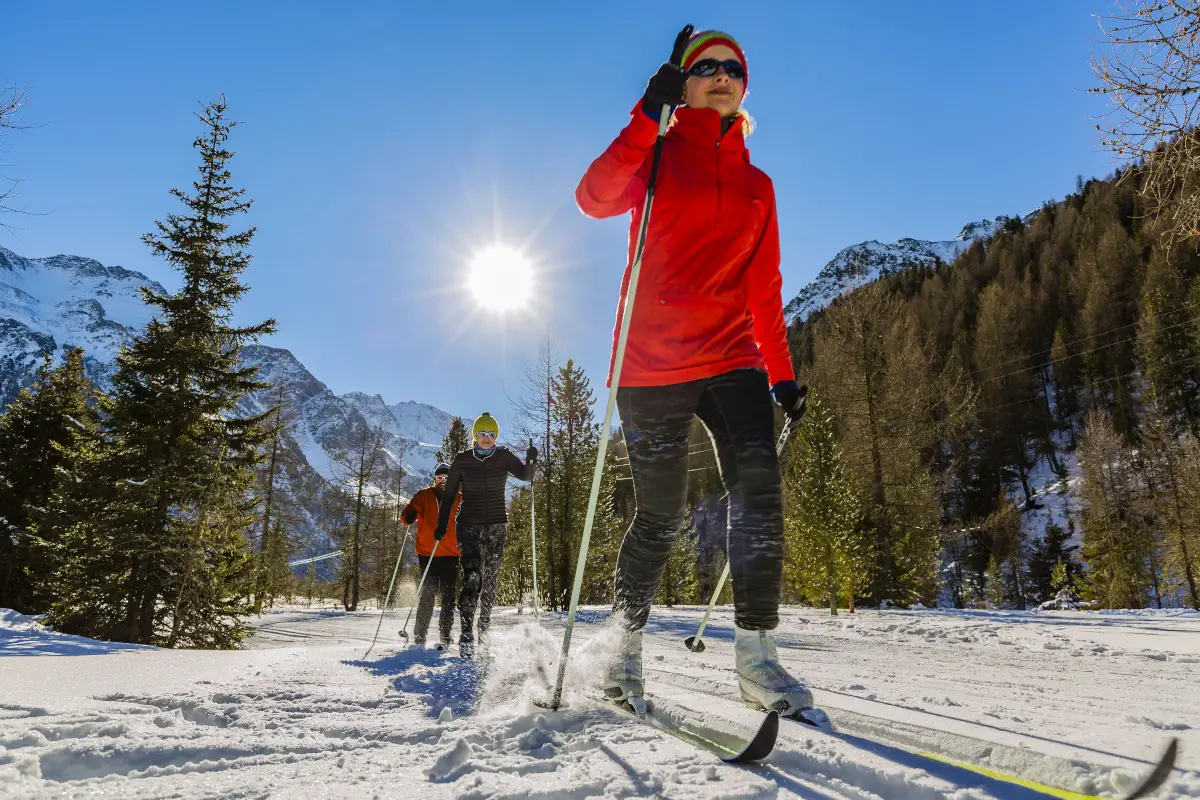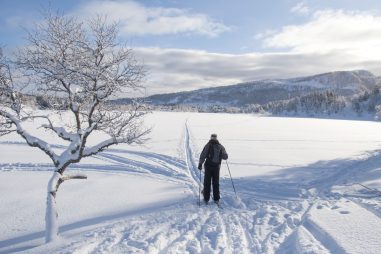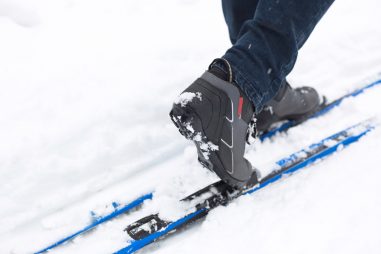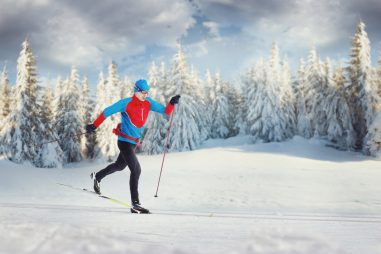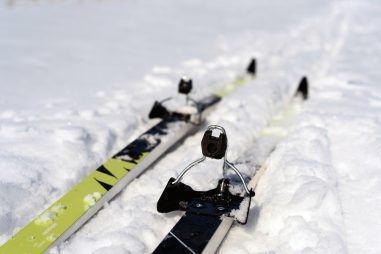One of the first things they’ll teach you when it comes to cross country skiing is to check the location’s weather conditions. Just because there’s snow means you can go cross country skiing whenever you want.
It’s part of the precautions you need to take to ensure your safety and that you have as much fun as you can. Things like temperature and wind and snow conditions are just a few things that can seriously affect your experience.
By knowing the best conditions for cross country skiing, you can minimize risk and maximize having fun!
What Temperature Is Best for Cross Country Skiing?
The ideal cross country skiing temperature is anywhere between -6°C to -1°C (20°F to 30°F). Under these conditions, snow will remain compact and won’t melt or turn slushy.
If we’re talking about comfort, that temperature range is also warm enough that you won’t freeze to death. However, you still have to watch out for heavy winds. They can draw the heat out of your body and make it too uncomfortable for you to ski.
For your ski wax, the low temperatures can make it more solid. But it’s not impossible to wax your cross country skis. You’ll just need to use the right ski wax.
What Temperature Is Too Warm for Cross Country Skiing?
Temperatures above -1°C (30°F) can be considered too warm for cross country skiing. The warm temperatures will melt the snow and ice, especially if it’s quite sunny. Snow won’t be compact enough to hold your weight and you might find yourself sinking into the ground.
As for melting ice, the water will make it too slippery to skate. It’s a risky condition that can lead to injuries.
How Cold Is Too Cold Cross Country Skiing?
The cold is more relative than warm weather. Since cross country skiing is a winter sport, it’s usually ideal when it’s colder.
If we’re talking about comfort level, some people find -10°C (14°F) already too cold for their bodies to take. But on the other hand, some are still able to cross country ski at -20°C (4°F). So it’s a matter of how much cold your body can take, even with the proper gear.
But if we consider official event guidelines for winter sports, some organizations cancel the competition if temperatures reach -30°C (-22°F) and below. The presence of strong winds and heavy snow can also be too risky for cross country skiing.
What Kind of Snow Is Best for Cross Country Skiing?
When it comes to snow conditions, light to medium density snow is best for cross country skiing. This gives you a smoother and more enjoyable ride.
The lighter the snow density, the easier it will be to push off the snow and ski. Heavier snow will require more effort which will use up more energy. You’ll end up tired at a faster rate.
Usually, temperatures of -6°C to -3°C (20°F to 25°F) give you the most ideal snow density. Pair this with a light snowfall and you’ll have the most enjoyable ski adventure yet!
How Much Snow Do You Need to Cross Country Ski?
Generally, 6 inches (15 cm) of snow will be enough for you to go cross country skiing. However, this still depends on the terrain you’re in. What’s under the snow is the most important consideration.
If you’re on a grassy field covered with snow, the 6-inch (15-cm) depth will sufficiently cover the terrain and allow you to ski with ease.
But if the terrain is filled with rocks, small boulders, or roots springing out of the ground, snow depth should be higher.
Can Snow Be Too Deep to Cross Country Ski?
If more snow is needed for certain terrain, is it possible to have too much snow? The answer is yes. Usually, the maximum depth is anywhere between 40 to 45 inches (101 to 114 cm). Continuous snow that will give you a higher snow depth than that can be considered too risky.
Too much snow can ruin the tracks and prevent proper grooming. When there’s too much snow or non-stop snowfall, deep snow can freeze and become too hard for skiing. It’s going to require more effort to ski so it won’t be as fun. But more importantly, the risk of accidents and an avalanche increases.
Can You Cross Country Ski in Wet Snow?
Experts don’t recommend skiing in wet snow, but it’s still possible. Wet snow or slush happens when temperatures become warmer and melt the snow, often when spring comes knocking.
It can also happen during the afternoon. Mornings are still icy and cool, and as the sun gets higher, the warmer it becomes. It turns the snow into slush and this consistency can tug on your skis, making it harder to slide and glide. So when skiing on wet snow, expect it to be more challenging than usual.
Is Wet Snow Good for Cross Country Skiing?
Wet snow isn’t ideal for cross country skiing. As mentioned above, it can give you more drag and you’ll need to exert more effort. Getting wet is also a real possibility if you fall. However, there are some positive things about it that some people prefer.
If you’re not used to the extreme cold, the warmer temperatures that bring wet snow may be more to your liking. The weather won’t be as punishing as it would be.
Also, since the slush can tug on your skis, you can’t go as fast. This can be more fun if you like going at a steady pace and warmer weather.
Can You Cross Country Ski on Snowmobile Trails?
You can cross country ski on snowmobile trails but you’ll have to use the skating technique. Since the trails are wider, they aren’t groomed for the standard cross country skiing technique.
If you’re not familiar with skate skiing, it’s best to avoid the snowmobile trails. And aside from this, it can be risky to share the trail with a motorized vehicle. Getting hit is always a risk especially if both the skier and snowmobile rider aren’t careful.
Also, it’s considered rude in some parks to use a trail meant for a different purpose or sport. Some skiers take offense when snowmobile riders use their trail and vice versa. There are various reasons for this, so before you hit the snowmobile trail, be sure to check the existing trail-sharing etiquette with the operators.
Can You Cross Country Ski on Hiking Trails?
You can cross country ski anywhere as long as there’s snow, and this includes hiking trails. Some hikers even switch to cross country skiing since you can propel yourself faster if you feel like it. But you’ll need touring skis to go off-trail.
Most hiking trails are also safe for cross country skiing, assuming there’s enough snow. Going off-trail is one of the advantages of cross country skiing. You can have your own adventure and experience nature in its rawest form.
Can You Cross Country Ski on Bike Trails?
In some parks, bike trails often share the same area, with a side groomed specifically for classic cross country skiing. If you plan to do classic cross country skiing, you’ll have to stick to your trail. However, you can go on the bike trail if you skate ski or use touring skis designed for off-trail skiing.
Bikers and skiers also follow specific riding etiquette to make sure everyone enjoys their time on the trail. That means bikers need to stay away from classic cross country tracks and give skate skiers a wide space to move.
Can You Cross Country Ski Without Tracks?
You can definitely go off-trail when cross country skiing. This is one of the things that make it more appealing than your regular resort skiing. But to ski without tracks, you’ll need to use touring skis.
You can use this ski type on and off track. You can go off track and cross country ski inside a park, on hiking trails, or any other terrain covered in snow. If you’re feeling more adventurous, you can explore the backcountry terrain to enjoy what nature has to offer.

